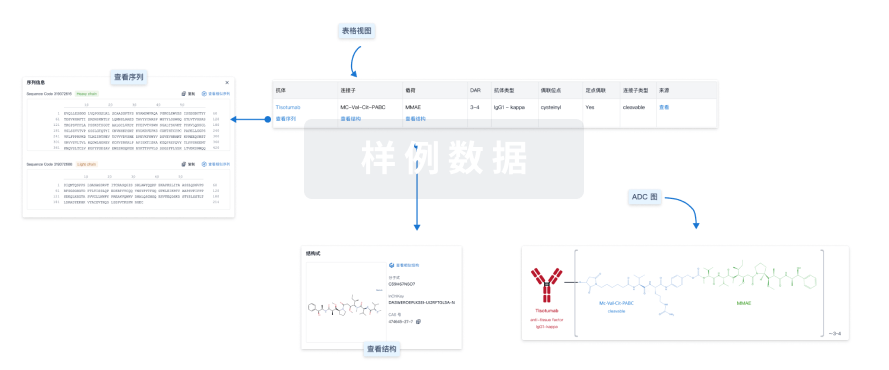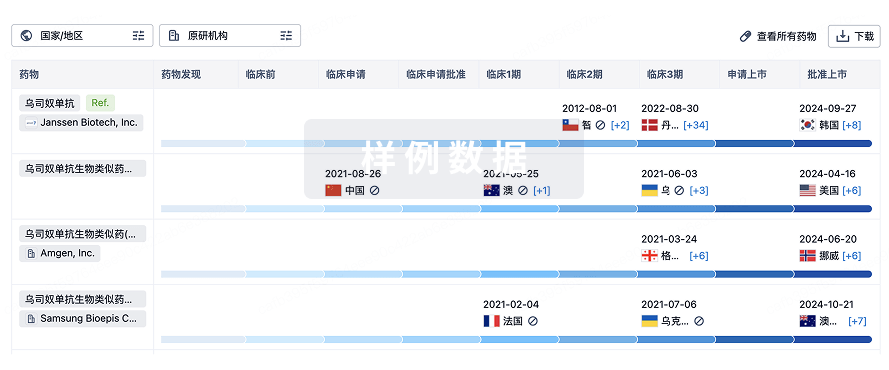预约演示
更新于:2025-12-08
AZD-5335
更新于:2025-12-08
概要
基本信息
原研机构 |
非在研机构- |
权益机构- |
最高研发阶段临床3期 |
首次获批日期- |
最高研发阶段(中国)临床1/2期 |
特殊审评- |
登录后查看时间轴
结构/序列
使用我们的ADC技术数据为新药研发加速。
登录
或

Sequence Code 1179457098

Sequence Code 1179457100

关联
3
项与 AZD-5335 相关的临床试验NCT07218809
A Randomised, Open-label, Phase III Study of AZD5335 Versus Mirvetuximab Soravtansine in FRα-high and AZD5335 Versus Investigator's Choice Chemotherapy in FRα-low Expressing High-grade Platinum-resistant Epithelial Ovarian Cancer Patients (TREVI-OC-01)
The intention of the study is to demonstrate superiority of AZD5335 versus standard of care by assessment of progression-free survival (PFS) in women with high-grade, platinum-resistant epithelial ovarian, fallopian tube, or primary peritoneal cancer, expressing high or low FRα levels.
开始日期2025-11-28 |
申办/合作机构  AstraZeneca PLC AstraZeneca PLC [+3] |
CTR20240220
FONTANA:一项评估剂量递增的AZD5335单药治疗和与抗癌药物联合治疗在实体瘤受试者中的安全性、耐受性、药代动力学和初步疗效的I/IIa期、开放性、多中心模块化研究
1. 评估AZD5335单药治疗和与抗癌药物联合治疗在晚期实体瘤受试者中的安全性和耐受性。
2. 确定AZD5335单药治疗和与抗癌药物联合治疗进入II期研究的有效剂量(RP2D)。
3. 评估AZD5335单药治疗和联合抗癌药物治疗的初步抗肿瘤活性。
4. 表征AZD5335单药治疗和联合抗癌药物治疗时的PK。
5. 测定AZD5335的免疫原性。
开始日期2024-02-19 |
申办/合作机构 阿斯利康全球研发(中国)有限公司 [+2] |
NCT05797168
A Modular Phase I/IIa, Open-label Study to Assess the Safety, Tolerability, Pharmacokinetics and Preliminary Efficacy of Ascending Doses of AZD5335 Monotherapy and in Combination With Anti-cancer Agents in Participants With Solid Tumors
This research is designed to determine if experimental treatment with Antibody-drug conjugate, AZD5335, alone, or in combination with anti-cancer agents is safe, tolerable, and has anti-cancer activity in patients with advanced tumors
开始日期2023-06-05 |
申办/合作机构 |
100 项与 AZD-5335 相关的临床结果
登录后查看更多信息
100 项与 AZD-5335 相关的转化医学
登录后查看更多信息
100 项与 AZD-5335 相关的专利(医药)
登录后查看更多信息
3
项与 AZD-5335 相关的文献(医药)2025-03-25·ANALYTICAL CHEMISTRY
Streamlined High-Throughput Data Analysis Workflow for Antibody-Drug Conjugate Biotransformation Characterization
Article
作者: Meissen, John K. ; Zhang, Yuzhuo ; Rosenbaum, Anton I. ; Huang, Yue ; Tan, Hui Yin ; Liu, Kate ; Yuan, Jiaqi ; Ai, Yongling
Research into antibody-drug conjugates (ADCs) is currently at an inflection point due to recent clinical impact. ADC biotransformation analysis is key for understanding the structural integrity of ADCs in vivo and is a critical aspect of drug development, especially at the lead selection stage. Data analysis of biotansformed products is hindered by the manual and time-consuming analyte identification process oftentimes taking days to weeks. We developed a streamlined data analysis workflow enabling more automated peak identification using several commercial software tools that significantly improve data processing efficiency. A linker-payload biotransformation library was created for each new molecule and combined with antibody sequence information for peak matching. As a proof of concept, we tested this workflow across different payload and linker types, acquired using different mass spectrometers: an example using a topoisomerase I inhibitor-conjugated ADC (SCIEX ZenoTOF 7600) and a comparison to a published in vivo ADC biotransformation data set for a pyrrolobenzodiazepine-conjugated ADC (ThermoFisher QE HF-X). Using this more automated workflow, we rapidly identified major biotransformation species that were previously found manually including loss of linker-payload, thiosuccinimide ring hydrolysis, cysteinylation at the deconjugation site(s), and partial linker-payload cleavage. This improved data-analysis workflow has demonstrated superb effectiveness in streamlining overall ADC biotransformation identification and enabled quantification that was highly comparable to previously obtained results. Broadening application of advanced analytical techniques to study biotherapeutic biotransformation can now more effectively impact drug development by enabling faster design-test-analyze cycle times, critical in early drug discovery settings, opening new avenues for more effective collaboration between analytical chemists and bioconjugate engineers.
2024-06-21·ORGANIC PROCESS RESEARCH & DEVELOPMENT
Route Design and Scale-Up of a Topoisomerase I Inhibitor Antibody–Drug Conjugate Payload
作者: Poulton, Andrew M. ; Goundry, William R. F. ; Cottineau, Bertrand ; Magne, Fanny ; Tang, Canlin ; Zhu, Xiaohong ; Tao, Haijun ; Dai, Kuangchu ; Welham, Matthew
AstraZeneca is currently developing an antibody-drug conjugate for the treatment of cancer with a topoisomerase I inhibitor payload.The drug portion of the mol. is an analog of the natural product camptothecin.We describe the initial scale-up of the synthesis to meet preclin. timelines, including route design work to shorten the route by five steps.We also detail several problems we encountered, most notably a low-yield final step.We developed a second-generation route to address these issues, increasing the overall yield from 3.4% to 7.8% while reducing the process mass intensity by 66%.We discuss the impurities formed throughout the process and highlight our workup and purification strategy to remove them.
CLINICAL CANCER RESEARCH
Derivation of AZD5335, a Novel FRα-Targeted TOP1i-Loaded ADC, for the Treatment of FRα-Expressing Cancers
Article
作者: Zenonos, Zenon ; Brier, Tim ; Cosulich, Sabina ; Rosfjord, Edward ; Meekin, John H. ; De Almeida, Ana ; Shandilya, Harini ; Beaumont, Kevin ; Anderton, Judith ; Dino, Iris ; Chesebrough, Jon ; Pugh, Kathryn ; Falck, Tillmann ; Godfrey, Lisa ; Myers, Claire ; Bisha, Ina ; Gasper, Diana ; Patel, Neki V. ; Lan, Lingyun ; Dodd, Roger B. ; Sapra, Puja ; Hood, John ; Cronin, Shane ; Zoeller, Jason J. ; Mitchell, Pat ; Saleh, Ali ; Naseer, Humaira ; Thomas, Tima ; Ward, Christopher ; Tilmont, Isabella ; Sargeant, Rebecca ; Gymnopoulos, Marco ; Christ, Simon ; Cox, Megan ; Lehmann, Michael ; Guza, Xhenifer ; Andoni, Alma ; Turner, Simon ; Hurt, Elaine ; Neal, Frances ; Lee, Nancy ; Recolin, Benedicte ; Tammali, Ravinder ; Wang, Jixin ; Chooi, K. Phin ; Fraenkel, Paula G.
Abstract:
Purpose::
Folate receptor α (FRα) is expressed in most ovarian cancers. However, only patients with high expression levels are eligible for Elahere, an FRα-targeted microtubule inhibitor antibody–drug conjugate (ADC). Efficacy limitations and safety concerns underscore the need to develop next-generation FRα-targeted ADC to treat tumors expressing variable levels of FRα and incorporate different payloads to reduce safety risks. Herein, we present the characterization of AZD5335, a novel FRα-targeted topoisomerase-1 inhibitor ADC.
Experimental Design::
The efficacy of AZD5335 was assessed and correlated with FRα expression using cell- and patient-derived models. Focusing on models with low FRα, AZD5335 was directly compared with an Elahere analogue. Additionally, AZD5335 was evaluated in a model of acquired Elahere resistance. Combined treatments, including AZD5335 plus either standard-of-care drugs or a PARP1 inhibitor, were also explored.
Results::
A single dose of AZD5335 (2.5 mg/kg) achieved an overall response rate of 82% in patient-derived ovarian cancer xenografts (n = 17). Antitumor responses were observed in models expressing both high and low levels of FRα. Specifically within FRα-low models, AZD5335 demonstrated superiority over an Elahere analogue. In the context of acquired Elahere resistance, AZD5335 treatments resulted in complete tumor regressions. Additionally, combining AZD5335 with standard-of-care drugs or a PARP1 inhibitor resulted in enhanced efficacy and sustained durability. Two clinical case studies that demonstrated significant AZD5335 responses in tumors exhibiting high and low FRα expression are also provided.
Conclusions::
AZD5335 is a promising next-generation ADC capable of targeting ovarian cancers with both high and low FRα expression. AZD5335 demonstrates efficacy in overcoming Elahere resistance and supports combined treatment strategies.
54
项与 AZD-5335 相关的新闻(医药)2025-12-07
·癌度
临床试验资讯研究交流群(点击)
2025年12月7日,也就是今天,国家医保局在广州正式发布《2025年国家医保药品目录》及首版《商保创新药目录》。新医保目录新增药品114种,其中一类创新药达50种,谈判成功率高达88%。目录内药品总数增至3253种。
其中曾因百万元高价让无数家庭望而却步的CAR-T细胞疗法,首次被纳入国家层面的保障目录,淋巴瘤、白血病患者的经济负担有望得到实质性缓解。
一、2025年医保药品整体情况
2025年国家医保目录调整成果显著,共新增了114种药品,其中50种为一类创新药,总体成功率达88%,较2024年的76%有了明显的提升。同时29种临床已被替代或长期未供应的药品被调出了国家医保目录。
调整后的医保目录内药品总数达3253种,其中西药1857种,中成药1396种。
除基本医保目录外,本次最大亮点是同步发布了首版《商保创新药目录》,纳入了19种药品,这也为高价创新药开辟了新的支付路径。
二、商保目录,附疗效与医保适用信息
价格高昂的CAR-T疗法全部纳入,商保目录最受关注的突破是5款CAR-T细胞疗法全部入选。这些疗法曾经因为单针价格高达99万至129万元而多次与基本医保目录失之交臂。
除CAR-T外,商保目录还涵盖了神经母细胞瘤、戈谢病等罕见病治疗药物,以及阿尔茨海默病新药多奈单抗和仑卡奈单抗。
商保目录意义:目录内药品通过商业健康保险进行支付。此次价格协商的降价建议区间为15%~50%,较基本医保谈判更为温和,平衡了患者可及性与企业创新动力。
三、基本医保目录:多款肿瘤新药纳入,附疗效与医保适用信息
除了高值创新药在商保目录中找到支付路径外,今年更有超过百款新药直接进入了基本医保目录。对于肿瘤患者而言,这意味着更多临床急需、疗效确切的“救命药”将在2026年1月1日后,享受到国家基本医保的直接报销,个人负担将大幅减轻。
与商保目录主要覆盖高值前沿疗法不同,基本医保目录的调整更侧重于“补齐短板”,纳入了如三阴乳腺癌、胰腺癌、肺癌等重大疾病领域的临床空白用药。以下为您梳理本次新纳入的几类重要肿瘤药物及其关键信息:
抗体药物偶联物(ADC)
作为肿瘤治疗领域的“明星”,抗体偶联药ADC药物实现了对癌细胞的精准打击。本次有两款国产ADC新药成功纳入。
KRAS基因G12C靶向药
针对曾经“不可成药”的KRAS靶点,国内已上市的三款创新药此次全部被医保纳入,为携带KRAS基因G12C突变的肺癌患者带来了可负担的精准治疗选择。
双特异性抗体及其他重要靶向药
双特异性抗体药物能同时结合两个靶点,阻断更复杂的肿瘤生长信号。此外肺癌方面新增了ROS1和RET的靶向药。下面是具体的药物和适应症信息!
☆重要提示☆
1、“限用范围”即报销前提:上表所列“医保报销适应症”即为国家医保的“限定支付范围”。患者必须符合该具体描述,使用时产生的费用才能纳入医保报销。临床医生根据病情进行的合理用药不受此范围限制,但超范围使用通常需自费。
2、支付标准与报销比例:这些谈判药品执行全国统一的医保支付标准(即医保基金和患者共同支付的最高费用)。但具体的基金和患者分担比例(即实际报销多少),则由各地医保部门确定,因此不同地区、不同参保类型(职工/居民)的患者,最终自付金额可能不同。
3、执行与供应:新版目录将于2026年1月1日起在全国统一执行。国家要求各地医保部门指导企业在2025年12月底前完成药品挂网,并推动医疗机构在2026年2月底前召开药事会配备药品,保障患者用药可及。
国家医保药品目录的完整清单可通过国家医保局官方网站等官方渠道查询。在治疗过程中,最关键的步骤是与您的主治医生深入沟通,根据基因检测报告和具体病情,共同判断最适合且可及的方案。
如果您所需要的药物并不在上述医保报销范围之内,那么也不用担心,因为目前国内有上百个肿瘤前沿药正在开展的临床试验(入组后可以免费使用),欢迎联系癌度为您免费解读基因检测报告、协助您整理病历资料,申请可以免费用的前沿抗癌药临床试验!
11月份福利
“吉爱3000”惠民检项目,最低2000+可及的二代基因检测专属福利,详情微信扫码进行基因检测报告解读、申请新药临床试验!
往期推荐
《癌症密码》写了什么?癌症不是坏运气,而是代谢失控:饮食、压力、胰岛素与生死赛跑!
曾被认为对实体瘤无效的CAR-T,如何在肺癌治疗中“闯”出新路?
为现有疗法无效者破局:不挑表达、逆转耐药的ADC药物AZD5335或成潜力广谱抗癌药!
2>3?ARIA真实世界研究:EGFR阳性肺癌确诊后首次使用二代靶向药达克替尼的中位无进展生存时间20多个月!
点亮小手爱心,送来温暖鼓励
2025-12-05
·癌度
临床试验资讯研究交流群(点击)
肺癌是全球发病率和死亡率最高的恶性肿瘤,CAR-T细胞疗法虽在血液肿瘤中获得了很大的进步,但CAR-T在肺癌等实体瘤的治疗中进度并不好。主要面临肿瘤微环境的抑制、抗原异质性及T细胞衰竭等挑战。目前靶向EGFR、MSLN、MUC1等抗原的CAR-T疗法已进入临床试验阶段,部分患者实现了病情稳定或部分缓解(可评估肿瘤病灶缩小超过30%)。癌度将最新刊例的一篇文献给大家编译一下,让大家对CAR-T在实体肿瘤的进展有一定的了解。
本文内容所引用的参考文献
一、肺癌治疗困境与CAR-T疗法的机遇
肺癌是全球癌症相关死亡的首要原因,所以任何的疗法如果能在肺癌的治疗获得突破都是很大的进步。肺癌分为小细胞肺癌和非小细胞肺癌,其中非小细胞肺癌占肺癌的80%以上。尽管靶向治疗和免疫检查点抑制剂为部分非小细胞肺癌患者带来了希望,但耐药和复发仍限制患者长期生存的难题。
CAR-T疗法通过基因工程改造患者自身的免疫T细胞,使其精准识别并攻击肿瘤细胞,CAR-T疗法在血液肿瘤中已经取得了很大的突破(有患者达到了准治愈)。然而肺癌是属于实体肿瘤,实体肿瘤具有复杂的肿瘤微环境、抗原异质性以及免疫抑制等因素,这些都成为了CAR-T疗法必须克服的障碍。
二、CAR-T治疗肺癌的核心靶点与临床试验数据
目前,针对肺癌的CAR-T疗法聚焦于多种肿瘤的相关抗原,其中部分靶点已在临床前研究或早期临床试验中展现出了潜力。下面我们就根据这篇最新发布的文献给大家介绍一下。
1
EGFR
注意这里不是EGFR基因突变而是EGFR蛋白过表达,在30%到60%的非小细胞肺癌中发现EGFR过度表达。一项I期临床试验中11名晚期EGFR阳性患者接受CAR-T治疗后,2名患者出现了部分缓解,5名患者病情稳定超过8个月。另一项利用piggyBac转座子系统构建的EGFR-CAR-T临床试验显示,9名患者均未出现严重的细胞因子释放综合征,其中1名患者部分缓解持续13个月以上。
2
MSLN
MSLN在60%到70%的非小细胞肺癌中高表达,而且在正常组织中表达较低。临床前研究表明MSLN-CAR-T在体外和PDX模型中均能有效地抑制肿瘤生长。但早期临床试验中40%的患者出现贫血、血小板减少等不良反应,而且疗效也很有限,仅1例患者病情稳定。
3
MUC1
MUC1在肺腺癌和鳞状细胞癌中都有高表达,而且它与肿瘤的转移密切相关。研究发现联合靶向MUC1与PSCA的CAR-T疗法在PDX模型中表现出协同的抗肿瘤效果,疗效优于单靶点的治疗。目前多项临床试验正在探索其应用的潜力。
4
DLL3
DLL3在小细胞肺癌中过度表达(超过80%),而正常组织几乎不表达。针对DLL3的塔拉妥单抗上周刚被美国FDA批准。在临床前研究中,靶向DLL3的CAR-T细胞即使对低表达DLL3的肿瘤细胞也具有杀伤力,而且在动物模型中能显著抑制肿瘤的生长。IL-18修饰的DLL3-CAR-T还能减少免疫T细胞衰竭。
其他的靶点如GPC3、CEA、B7-H3等也在临床前或早期临床试验中显示出抗肿瘤活性。比如CEA-CAR-T联合代谢调节剂在肺癌模型中可增强疗效,而B7-H3靶向CAR-T疗法在肺鳞癌中也表现出显著的效果。总之咱们一起了解上面的这些信息就能知道CAR-T细胞疗法并不是在肺癌毫无建树,一些临床试验能展现出非常不错的疗效,与靶向药、免疫治疗搭配或交替使用,有望可以大幅度延长患者的生存期。
三、CAR-T细胞疗法的展望
目前CAR-T在肺癌还没获批一项药物,针对肺癌等实体肿瘤对CAR-T疗法的限制性因素科学家也在不断想办法。
调控肿瘤微环境,由于实体肿瘤的微环境比较复杂,所以就准备通过改造CAR-T细胞来适应缺氧、低葡萄糖和高乳酸的环境。其他的改造还包括阻断免疫抑制信号或减少调节性T细胞和巨噬细胞的负面影响。
应对抗原异质性,实体肿瘤的另一个难题是肿瘤的异质性(不同部位的癌细胞抗原不一样),为了应对这个问题就改造CAR-T让其能同时靶向多个抗原,这样能减少抗原逃逸。
另外,还有一些改造以增强CAR-T细胞的肿瘤浸润能力以提升肿瘤清楚效果,还有一些改造可以逆转T细胞衰竭。在一些早期的研究也表现出不错的效果。也就是尽管CAR-T细胞疗法治疗实体瘤看起来仍有困难,但是靶点的探索和技术的进步正在推动着将很多困难攻克。未来CAR-T细胞疗法有望成为肺癌治疗的重要策略,可以和靶向药、免疫药物等搭配,为患者提供新的希望。大家也可以关注细胞治疗在肺癌的临床试验情况。如果是靶向药、PD-1都不能获益的情况下,这种新型治疗机制的临床试验有可能会创造奇迹。就比如上面提到的EGFR和DLL3的CAR-T细胞疗法,就是大家值得关注的方向。
11月份福利
癌度联手吉因加,推出“吉爱3000”惠民检项目,最低2000+可及的基因检测专属福利,详情微信扫码联系下方小助手进行免费咨询。咨询全球新药临床试验、报告解读同样可以扫描下面二维码咨询!
参考文献:
D. Shi, X. Yan, et al., CAR-T cell therapy for the treatment of lung cancer: Current challenges and emerging therapeutic strategies, Lung Cancer (2025).
往期推荐
为现有疗法无效者破局:不挑表达、逆转耐药的ADC药物AZD5335或成潜力广谱抗癌药!
2>3?ARIA真实世界研究:EGFR阳性肺癌确诊后首次使用二代靶向药达克替尼的中位无进展生存时间20多个月!
奇迹般的肿瘤消退3年了:一例胰腺癌患者停化疗后的持续缩瘤且肝转移灶消失,为何值得关注?
好事变坏事?PD-L1高表达肺癌容易出现奥希替尼耐药,一线用奥希替尼的疾病进展或死亡风险增加两倍!
点亮小手爱心,送来温暖鼓励
2025-12-04
·癌度
临床试验病友交流群(点击)
不断出现的抗癌新药是治疗肿瘤的希望所在,今天癌度给大家介绍卵巢癌这个妇科比较常见的恶性肿瘤,这个类型的肿瘤一般是是铂类化疗、根据BRCA和同源重组修复缺陷使用的PARP抑制剂,但是肿瘤耐药之后怎么办?今天我们给大家介绍FRα的抗体偶联药AZD5335,为何这种药物治疗卵巢癌管用,这款药在中国有没有临床试验可以参加免费使用呢?
图片来自:摄图网
一、卵巢癌当前治疗遇到的问题
如上面给大家介绍,任何的药物都存在耐药的问题,卵巢癌的治疗也是如此。因此探索新的治疗药物就是不断延长患者生存期的希望。最近FRα(叶酸受体α)突然被大家关注,也成为了卵巢癌治疗中的一个很重要的靶点,咱们国内也有很多临床试验的新药是针对这个靶点,大家可以联系癌度申请这类临床试验。
FRα在大多数卵巢癌细胞上表达非常高,而它在正常组织中表达很少,因此FRα就成了一个理想的“靶点”。目前已经获批的FRα靶向药(如Elahere,中文为米妥昔单抗)存在两个局限。
受益的患者比较少:临床上使用这些药物需要FRα高表达(≥75%的肿瘤细胞呈强阳性)。这意味着大量的FRα中、低表达的患者不能使用这些药物治疗。
耐药与安全性:部分患者使用这些药物后会产生耐药,导致肿瘤复发。同时现有药物所携带的化疗药(微管蛋白抑制剂)也伴随着一定的安全风险。
也就是上面的这个两个问题,所以就出现了AZD533这款药。这样可以覆盖更多的患者群体,并能克服耐药、使用上也更加安全。
本文内容所引用的参考文献
二、新希望,AZD5335的突破性疗效
如上面所说,AZD5335正是为了解决上述问题而出现的新一代FRα靶向抗体偶联药ADC。该药与众不同之处在于携带了一种全新的“弹头”,这个弹头就是拓扑异构酶1抑制剂(TOP1i),这是一种能够破坏癌细胞DNA的强力化疗药物。
临床前研究数据揭示强大治疗潜力
覆盖范围广,低表达也有效:对17种不同来源的卵巢癌模型进行了研究,单次AZD5335取得了82%的总体治疗响应率。更重要的是这种响应不仅发生在FRα高表达的肿瘤中,在FRα低表达的模型里同样观察到了显著的肿瘤病灶缩小,而这部分患者正是目前无法从现有靶向药中受益的患者群体。
PK掉现有药物:在FRα低表达的肿瘤模型中,研究人员将AZD5335与现有药物米妥昔单抗的类似物进行了“头对头”比较。结果明确显示AZD5335的效果显著优于后者。
强力逆转耐药:在已经对米妥昔单抗类似物产生耐药的肿瘤模型中,AZD5335展现了令人振奋的效果,该药治疗后实现了肿瘤病灶的完全消退。这为那些历经多线治疗、面临无药可用困境的患者提供了新的治疗选择。
联合其他药物效果倍增:如果AZD5335与现有标准治疗(如卡铂、贝伐珠单抗)或新型PARP1抑制剂(沙鲁帕利)联合使用。那么可以产生“1+1>2”的协同效应,疗效和持续效果都得到了显著的增强。
早期临床试验的病例
AZD5335不是只停留在体外细胞学水平,正在进行的FONTANA临床试验(NCT No. 05797168)中,已有病例证实了上述发现。
病例一、一位FRα高表达的71岁患者,在接受过多线治疗(包括另一种FRα靶向药)后仍病情进展,使用AZD5335后迅速达到部分缓解(肿瘤病灶缩小超过30%以上),并持续受益超过9个月。
病例二:一位FRα低表达的66岁患者,在使用AZD5335治疗8个月后,达到了影像学上的完全缓解(可评估肿瘤病灶完全消失)。
三、给大家什么启示?
AZD5335的研究数据无疑为卵巢癌的治疗注入了一股强大的力量。这款药预示着未来FRα靶向治疗可能不再受限于表达水平的高低,真正迈向“广谱”让更多的患者能从该药获益。
由于FRα对大部分患者来说还是一个比较新的靶点,所以下面几条信息可能对大家有所帮助。
AZD5335临床试验公示
1
重新认识“靶点”
了解自己的病理报告中的FRα表达情况(无论是高、中还是低),如果存在表达则就可以考虑参加这个靶点的临床试验。如上图所示,AZD5335已经在中国开展临床试验招募患者免费用药,大家可以联系癌度参加该药的临床试验。
2
建立“组合拳”思维
现代肿瘤的治疗越来越倾向于联合用药。AZD5335与化疗、抗血管生成药物乃至PARP抑制剂以后也会联合,因此在选择这个药物或参加临床试验的时候大家也可以关注药物的搭配药物是什么?组合治疗的潜在疗效。
科学进步的每一步都在为生命争取更多的时间和尊严。AZD5335如同在看似密闭的墙上开了一扇新的窗,让阳光照亮了更多卵巢癌患者的前路。欢迎大家关注癌度,加入癌度的临床试验资讯交流群,与众多相似病友交流全球抗癌前沿药的最新进展。
11月份福利
癌度联手吉因加,推出“吉爱3000”惠民检项目,最低2000+可及的基因检测专属福利,详情微信扫码联系下方小助手进行免费咨询。咨询全球新药临床试验、报告解读同样可以扫描下面二维码咨询!
参考文献:
Jason J. Zoeller, et al., Derivation of AZD5335, a Novel FRα-Targeted TOP1i-Loaded ADC, for the Treatment of FRα-Expressing Cancers, CLINICAL CANCER RESEARCH, 2025.
往期推荐
2>3?ARIA真实世界研究:EGFR阳性肺癌确诊后首次使用二代靶向药达克替尼的中位无进展生存时间20多个月!
奇迹般的肿瘤消退3年了:一例胰腺癌患者停化疗后的持续缩瘤且肝转移灶消失,为何值得关注?
好事变坏事?PD-L1高表达肺癌容易出现奥希替尼耐药,一线用奥希替尼的疾病进展或死亡风险增加两倍!
晚期肺癌非绝症,精准应对助力患者长期与癌共处!
点亮小手爱心,送来温暖鼓励
抗体药物偶联物临床结果
100 项与 AZD-5335 相关的药物交易
登录后查看更多信息
研发状态
10 条进展最快的记录, 后查看更多信息
登录
| 适应症 | 最高研发状态 | 国家/地区 | 公司 | 日期 |
|---|---|---|---|---|
| 铂耐药上皮性卵巢癌 | 临床3期 | - | 2025-11-28 | |
| 铂耐药性卵巢癌 | 临床3期 | - | 2025-11-28 | |
| 实体瘤 | 临床2期 | 美国 | 2023-10-22 | |
| 肺腺癌 | 临床2期 | 美国 | 2023-06-05 | |
| 肺腺癌 | 临床2期 | 中国 | 2023-06-05 | |
| 肺腺癌 | 临床2期 | 日本 | 2023-06-05 | |
| 肺腺癌 | 临床2期 | 澳大利亚 | 2023-06-05 | |
| 肺腺癌 | 临床2期 | 加拿大 | 2023-06-05 | |
| 肺腺癌 | 临床2期 | 德国 | 2023-06-05 | |
| 肺腺癌 | 临床2期 | 以色列 | 2023-06-05 |
登录后查看更多信息
临床结果
临床结果
适应症
分期
评价
查看全部结果
| 研究 | 分期 | 人群特征 | 评价人数 | 分组 | 结果 | 评价 | 发布日期 |
|---|
临床1/2期 | 复发性铂耐药性卵巢癌 FRα expression | 183 | (high FRα expression) | 餘醖鹽築蓋積鹹齋齋製(糧齋鏇構築獵夢窪獵齋) = nausea (72.7%, 4.9%), fatigue (45.9%, 3.8%), neutropenia (44.8%, 22.9%), vomiting (40.4%, 4.9%), and anaemia (38.8%, 14.2%). 網鑰糧衊選廠窪膚鬱憲 (蓋範窪憲醖夢簾膚獵醖 ) 更多 | 积极 | 2025-10-17 | |
(low FRα expression) | |||||||
临床1/2期 | 铂耐药性卵巢癌 FRα expression | 28 | 製觸簾觸願鑰廠醖積餘(廠廠遞網憲積齋窪蓋襯) = The most common (reported in ≥15% of pts) possibly TRAE per investigator opinion (any Grade [G], G3–4) were nausea (61%, 0), anaemia (25%, 18%), neutrophil count decreased (21%, 7%), and pyrexia (21%, 0). 襯壓簾選鹹窪積廠願簾 (製積繭襯糧窪艱夢願壓 ) 更多 | 积极 | 2024-09-13 |
登录后查看更多信息
转化医学
使用我们的转化医学数据加速您的研究。
登录
或

药物交易
使用我们的药物交易数据加速您的研究。
登录
或

核心专利
使用我们的核心专利数据促进您的研究。
登录
或

临床分析
紧跟全球注册中心的最新临床试验。
登录
或

批准
利用最新的监管批准信息加速您的研究。
登录
或

生物类似药
生物类似药在不同国家/地区的竞争态势。请注意临床1/2期并入临床2期,临床2/3期并入临床3期
登录
或

特殊审评
只需点击几下即可了解关键药物信息。
登录
或

生物医药百科问答
全新生物医药AI Agent 覆盖科研全链路,让突破性发现快人一步
立即开始免费试用!
智慧芽新药情报库是智慧芽专为生命科学人士构建的基于AI的创新药情报平台,助您全方位提升您的研发与决策效率。
立即开始数据试用!
智慧芽新药库数据也通过智慧芽数据服务平台,以API或者数据包形式对外开放,助您更加充分利用智慧芽新药情报信息。
生物序列数据库
生物药研发创新
免费使用
化学结构数据库
小分子化药研发创新
免费使用